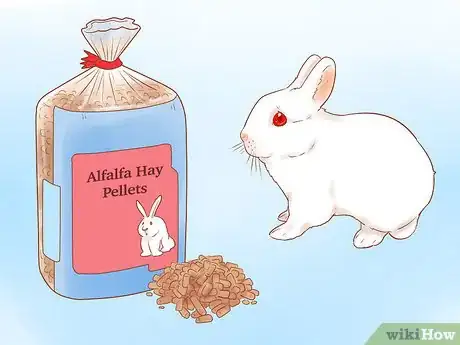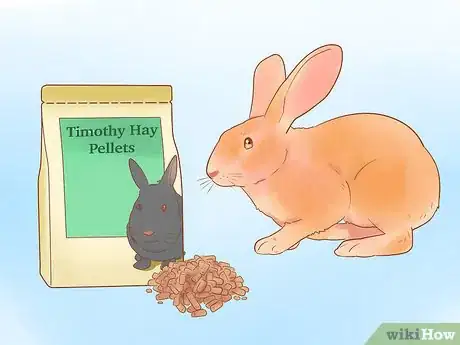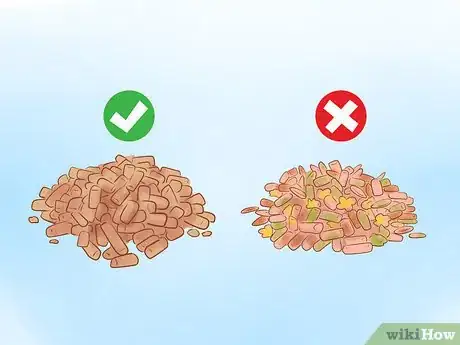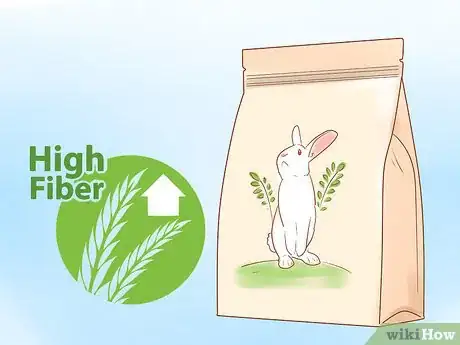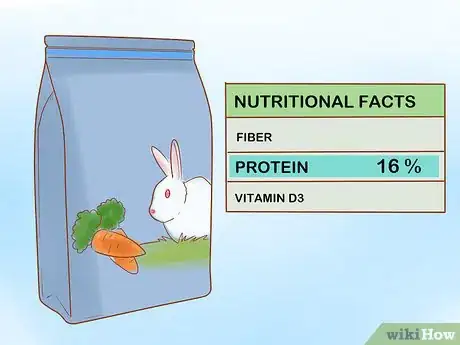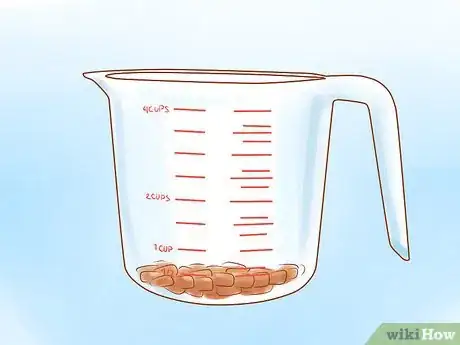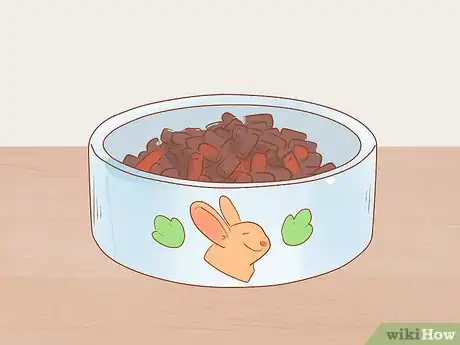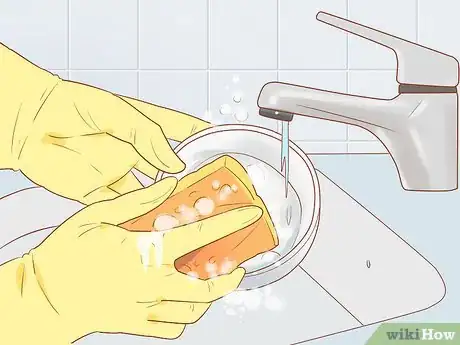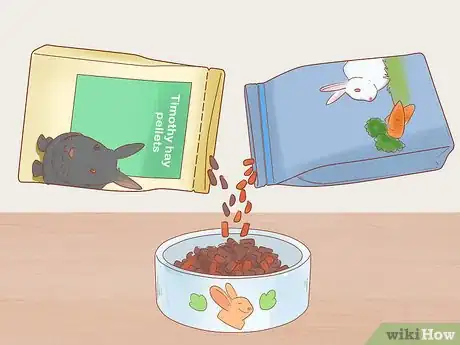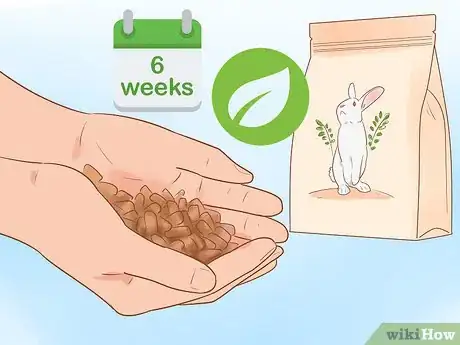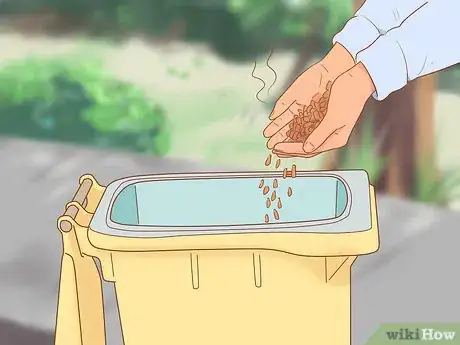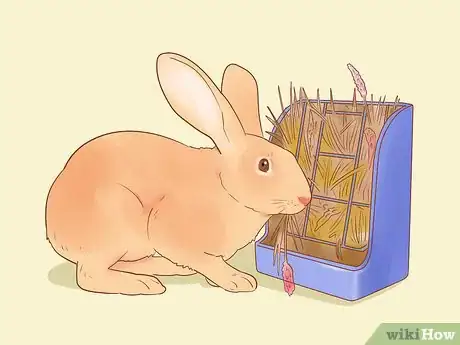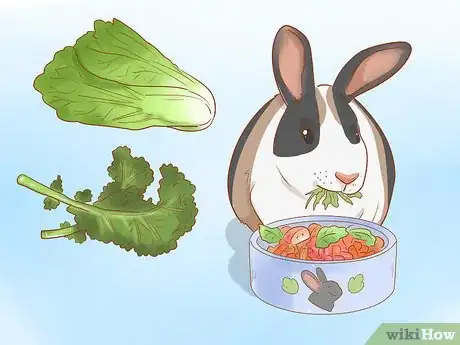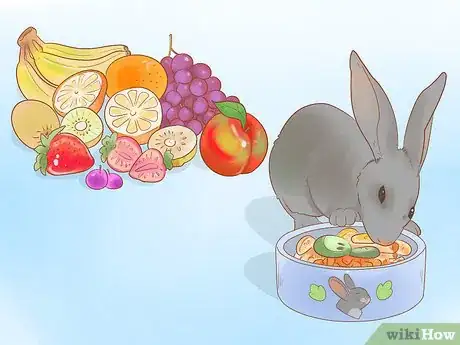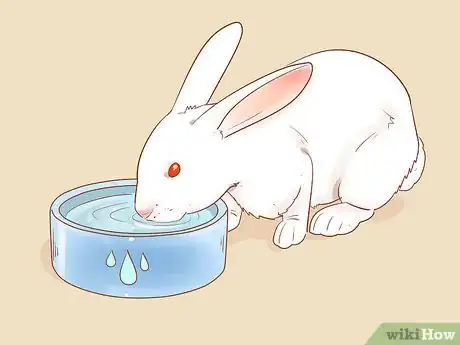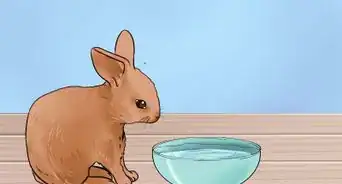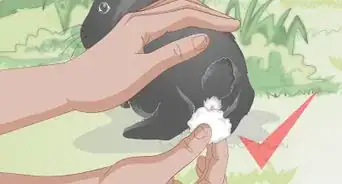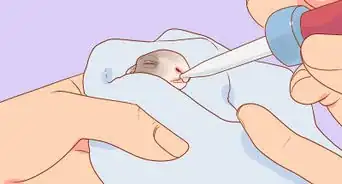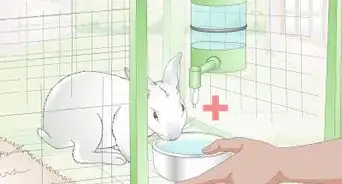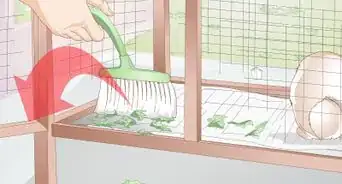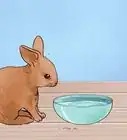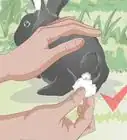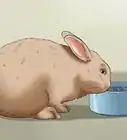This article was co-authored by Pippa Elliott, MRCVS. Dr. Elliott, BVMS, MRCVS is a veterinarian with over 30 years of experience in veterinary surgery and companion animal practice. She graduated from the University of Glasgow in 1987 with a degree in veterinary medicine and surgery. She has worked at the same animal clinic in her hometown for over 20 years.
There are 10 references cited in this article, which can be found at the bottom of the page.
This article has been viewed 45,890 times.
Dry pellets are very nutritious, so most owners feed them to their pet rabbits. Young bunnies, underweight rabbits, and even picky eaters benefit from having pellets as part of their diet. Pellets are a great choice as long as you use them sparingly and supplement them with hay, fruits, and vegetables. By monitoring your rabbit's diet, you can help give it a longer and healthier life.
Steps
Purchasing Rabbit Pellets
-
1Choose alfalfa hay pellets for rabbits younger than 7 months. Rabbits like alfalfa, so most will gobble up alfalfa pellets. Alfalfa is high in nutrients like calcium, making these pellets a great choice for growing rabbits. Switch them out for timothy hay pellets when your furry friend reaches adulthood.[1]
- Alfalfa pellets can be supplemented with alfalfa hay, but you usually don't need to give a rabbit both. Try giving your rabbit timothy hay instead of alfalfa hay.
- Alfalfa is too rich for adult rabbits, so transition them to different pellets by the time they reach the ripe old age of 1 year.
-
2Select timothy hay pellets for adult rabbits. Quality timothy hay feeds are not quite as nutrient-rich as alfalfa pellets, but they still have plenty to offer to rabbits over 7 months old. Pick out something nutritious that fits within your budget. Begin transitioning younger rabbits to timothy hay pellets by mixing small amounts in with their regular food.[2]
- Transition your rabbit's diet gradually to avoid digestive problems. Change the food you put out by about 10% each day. Your rabbit will adapt quickly to the new food, especially pellets.
Advertisement -
3Get plain pellets without seeds or nuts. Many stores sell fancy pellets or colorful mixes. They catch your eye, making you feel like they're a better option than those dull, gray pellets. The plain pellets actually tend to be safer and more nutritious. Avoid pellets with additives and grains your rabbit doesn't need in its diet.[3]
- Stick to pellets that look plain and have a consistent appearance. They are the best choice for a rabbit's diet.
- Fiesta mixes with several different colors and shapes are healthy but often poor choices as rabbit food. Most rabbits will pick out what they like and enjoy the healthier components.
-
4Pick pellets that contain more grass than grains. Check the ingredients list on a package of pellets to see the nutritional content. Make sure alfalfa hay, timothy hay, or a similar ingredient is high on the list. You may see it listed as “grass.” As long as it's above ingredients like wheat or cereal, the pellets are safe to consider as part of your rabbit's diet.[4]
- Grains like wheat and cereal don't add a lot of nutrition to your rabbit's diet. They're more like filler that can fatten up your rabbit without nourishing it.
-
5Purchase pellets that consist of at least 18% fiber. Fiber comes from grass ingredients like hay. Fiber is very good for a rabbit's digestive system. They need much more fiber than protein, so check the ingredient label carefully to ensure your rabbit is as healthy as possible.[5]
- Pellets high in fiber can get costly, but keep in mind that rabbits don't need to eat a lot per day. Supplement pellets with vegetables and hay to save money.
-
6Get pellets with additional protein if you are feeding a young bunny. Adult rabbits need pellets that are 12% to 14% protein. Bunnies under 5 months old can have extra protein to help them grow strong and healthy. Look for pellets that are around 16% protein.[6]
- Make sure the protein content isn't higher than the fiber content, even while feeding a growing bunny.
Giving Pellets to Your Rabbit
-
1Feed your rabbit a maximum of 3 oz (85 g) of pellets a day. As a rule of thumb, give a rabbit between ¼ to ½ a cup of pellets for every 6 lb (2.7 kg) of its body weight. This also varies depending on your rabbit's activity level and metabolism. Monitor your rabbit's weight and give it fewer pellets if it doesn't eat them all during mealtime.[7]
- Technically, rabbits don't need pellets. Some people choose a natural diet consisting of hay and green vegetables. However, pellets are nutritious and far easier to provide every day.
- Growing bunnies are allowed to have more pellets. Also, give older rabbits more pellets if they need to gain weight.
- Don't be fooled by a rabbit gobbling up pellets! Pellets are rich with nutrients, so many rabbits eat them quickly. Giving an adult rabbit more pellets than it needs leads to obesity.
-
2Put the pellets in a container or a treat ball. A ceramic bowl works well for everyday use. Choose a heavy bowl so your rabbit doesn't knock it over while its hopping around its cage. Heavy plastic, steel, and glass are a few alternatives to place on the floor of the cage. When you take your rabbit out of the cage, consider using a treat ball to get it some extra exercise.
- Keep bowls on the cage floor near the walls to prevent them from tipping over and breaking. If you have multiple rabbits, spread the bowls out so they all get a chance to eat.
- When your rabbit pushes the treat ball, the pellets fall out. Rabbits don't need a lot of pellets each day, so they practically function as healthy treats. Your rabbit won't mind.
-
3Clean food bowls daily with soap and water. After your rabbit finishes eating, remove the bowl or treat ball. Remove any uneaten food, then scrub the bowl to remove leftover debris. Return the food bowl the next day when you're ready to give your rabbit fresh pellets.
- Since rabbits have sensitive digestive systems, remove leftover food particles every day. Cleaning out the bowl thoroughly eliminates stale food particles, bacteria, and mold that can be harmful to a rabbit.
-
4Mix new pellets into old feed gradually to encourage your rabbit to eat. Rabbits are finicky eaters, so your pet may be hesitant to try something out of the ordinary. If you have to bring home a new pellet brand, set aside some of the old feed. Replace about 10% of your rabbit's meal with the new pellets. Increase the amount by 10% each day until your rabbit adjusts.[8]
- Rabbits have very sensitive digestive systems, so a sudden switch in pellets often makes them feel a little sick. Change out food gradually to keep your pet healthy.
Storing Pellets
-
1Keep fresh pellets for no longer than 6 weeks. Buy pellets in limited quantities so you don't end up feeding your rabbit spoiled food. After about 6 weeks, throw the old pellets away. Visit a pet supply store to get fresh pellets for your rabbit to enjoy every day.[9]
- To ensure your rabbit gets fresh food, limit the amount of pellets you keep on hand. Some supply stores sell gigantic bags of pellets. Your rabbit probably will not get through the entire bag before the pellets start to spoil.
-
2Preserve the pellets in a clean, closed container. Protect the pellets as much as possible from bacteria and other problems that can affect your rabbit's health. Keep the container closed when you're not using it. Move it to a cool, dry place like a pantry or closet so the pellets stay fresh longer.[10]
- Pick up a plastic pet food container at your local pet store or general store. Use it for an easy way to keep your rabbit's food fresh.
-
3Throw away pellets that look dry or smell rancid. Pellets that look rotten probably are rotten. Don't take a chance on feeding them to your beloved pet. Pellets dry out over time. Old pellets may look or feel crumbly, smell rancid, or show signs of mold growth.[11]
- If you think the pellets may be spoiled, throw them away. Fresher pellets are always better for a rabbit.
Supplementing a Pellet Diet
-
1Provide unlimited alfalfa hay for bunnies under 7 months old. Rabbits need hay for lots of reasons, including to wear down their teeth and improve their digestion. Provide the hay in a clean dish or tray. When your rabbit eats it all, put more in. Hay is the main component of your rabbit's diet and they will graze on it all day.[12]
- Alfalfa hay is safe for young bunnies, but if you're also feeding your pet alfalfa pellets, consider switching to timothy hay.
-
2Feed unlimited timothy hay or an alternative to adult rabbits. Timothy hay is the main food source of adult rabbits, and you can get quality hay at a pet supply store. Oat hay, orchard hay, and brome are some acceptable alternatives. Keep a supply of hay in a bowl or tray that is always accessible to your rabbit.[13]
- If you fed your pet alfalfa hay as a bunny, mix in some with the new timothy hay to help transition it to a healthier diet.
- Your rabbit needs the hay to graze. If it doesn't eat enough hay, it may look for additional pellets or vegetables.
-
3Add plenty of vegetables to a bowl of pellets. Pellets are meant to be a small part of a rabbit's diet. Green vegetables like romaine lettuce, herbs, kale, and turnip greens are a few options to pick up from your local supermarket. On average, a rabbit needs about 10 oz (280 g), or 2 cups, of vegetables for every 6 lb (2.7 kg) of its body weight.[14]
- Vegetables like broccoli, celery, bell peppers, and carrots are safe, but offer them sparingly. Make them no more than 15% of your rabbit's diet, offering them once or twice a week.
- The amount of vegetables you offer your rabbit depends on how many pellets you give it. Keep it proportional. Your rabbit needs fewer pellets when you give it more vegetables.
-
4Offer small amounts of fruit as a treat for your rabbit. The high sugar content in fruit means it's not a replacement for pellets. Some options for fruit treats include bananas, berries, peaches, and apple slices. As a rule, give your rabbit about 1⁄2 oz (14 g) of fruit for every 6 lb (2.7 kg) of its body weight. Limit the treat to once or twice a week.[15]
- Wash fruit and remove stems and seeds before giving it to your rabbit. Fruit like apples, watermelons, and cherries are safe as long as you take out the seeds.
- Other foods, including meat and grains, aren't safe for rabbits. Avoid giving your bunny human treats.
-
5Give your rabbit plenty of water in a clean bowl. The best way to serve water is in a heavy bowl. Place the bowl in a corner of your rabbit's cage. Change out the water every day, washing the bowl with soap and hot water. With a steady supply of food and water, your rabbit will be well cared for.[16]
- Keep an eye on the water bowl. When it's empty, fill it up again.
- Hanging water bottles are an option, but many rabbits have problems using them. Also, they are more difficult to clean than bowls.
Warnings
- Pellets can be pretty fattening, so monitor how much your rabbit eats. Give it more hay and vegetables to avoid overfeeding it with pellets and treats.⧼thumbs_response⧽
- Food and hay expire over time, so keep a close eye on them. Spoiled foods are very harmful for rabbits. Throw away anything that looks moldy or smells rancid.⧼thumbs_response⧽
Things You'll Need
- Large storage container with lid
- Pellets
- Vegetables
- Fruits
- Hay
- Food bowls
- Water bowl
- Water
- Measuring cup or spoon
- Knife
- Soap
- Sponge
References
- ↑ http://www.bunnygroomer.com/nutrition.html
- ↑ http://www.bunnygroomer.com/nutrition.html
- ↑ http://www.bio.miami.edu/hare/diet.html
- ↑ http://www.indianahrs.org/rabbit-care/food-pellets-hay.aspx
- ↑ http://www.indianahrs.org/rabbit-care/food-pellets-hay.aspx
- ↑ http://www.bio.miami.edu/hare/diet.html
- ↑ https://therabbithaven.org/feeding-your-rabbit
- ↑ https://vcahospitals.com/know-your-pet/rabbits-feeding
- ↑ https://www.petmd.com/rabbit/nutrition/evr_rb_what-do-you-feed-a-rabbit
- ↑ https://www.petfinder.com/pet-care/rabbit-care/feeding-basics-rabbits/
- ↑ http://www.threelittleladiesrabbitry.com/feeding.php
- ↑ https://therabbithaven.org/feeding-your-rabbit
- ↑ https://therabbithaven.org/feeding-your-rabbit
- ↑ http://www.indianahrs.org/rabbit-care/greens-vegetables.aspx
- ↑ https://bestfriends.org/resources/rabbit-diet-what-feed-bunny
- ↑ https://vcahospitals.com/know-your-pet/rabbits-feeding
